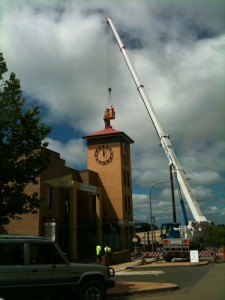Controversial Leura mobile tower gets ready
Despite a number of protest letters, and backing from the local school newsletter, the 3G tower has been installed on top of the Spires. The photo below shows the crew preparing it for activation.
Although protesters suggest any level of electromagnetic radiation is unsafe, at least siting the tower in a high location, in an area generally commercial, rather than residential, and several hundred metres from the school, takes advantage of the inverse square law to give broad coverage at lower power levels. And compared to some towers it doesn’t look that bad.
Vodafone also responded to objections to the tower on health and safety grounds, citing evidence the power levels at which it would be operated are below accepted standards. The reply is unlikely to mollify protesters, however, as it basically says there is nothing to worry about according to science, rather than addressing the protesters non-scientific concerns that in the future there may be evidence that mobile towers are health hazards.

Leura's new mobile tower approaches commisssioning
November 19th, 2009 17:54
I get bad Vodafone 3G reception inside my house. Hoepfully, this will fix it.
February 11th, 2010 08:02
It probably will, Tim.
Considering the power output of a 3G node is about 3 watts, there’s no reasonable chance they can cause any health problems. The people who oppose them don’t understand that non-ionising radio signals can’t affect anyone’s health. They rely on scientifically unsupportable scare tactics to drive their points.
There’s no reliable, peer-reviewed study which has ever revealed any health effects from mobile phone towers. In fact, quite the opposite. The World Health Organisation’s statement on them at http://www.who.int/mediacentre/factsheets/fs193/en/ says: “None of the recent reviews have concluded that exposure to the RF fields from mobile phones or their base stations causes any adverse health consequence.”
Mobile phones and associated towers are not just safe, they’re an awful lot safer than exposure to sunlight.